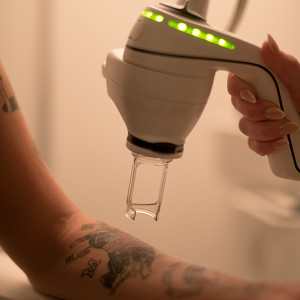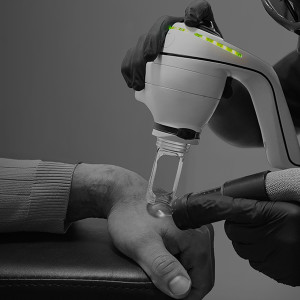A question asked so regularly; yet rarely answered with real clarity. In an age where nearly every question can be answered with just a few words typed into a google browser, this lack of certainty can be frustrating.
Here, expect straight-talking, fact-driven, real answers, covering the main variables which determine whether your tattoo can be removed effectively. These include the different types of tattoo removal, the immune system, ink properties, individual skin types, tattoo location as well as pregnancy and different health conditions.
The good news is, after a huge amount of investment and research over the last decade, the options for removing your ink are now better than ever. New and advanced technology means that now, more people than ever before can experience effective tattoo removal - with less pain, less damage, and faster, better results.
CONTENTS
Different types of tattoo removal
The immune system
Different tattoo inks
Where the tattoo is on the body
Different skin types
Pregnancy and health conditions
NAAMA Studios tattoo removal
1. Different types of tattoo removal
There are several different types of tattoo removal - some of which are more effective than others. Before laser tattoo removal came along, there were several different methods for attempting to remove ink from the skin - many of which are now largely avoided. These include Salabrasion (scrubbing the skin with salt), Dermabrasion (an intense exfoliation), Cryosurgery (skin grafting) and TCA (an acid that removes layers of the skin). There have even been reports of people using homemade solutions like cheese-graters in a desperate attempt to remove their ink!
Not only are these techniques extremely damaging and painful, but they’re very ineffective: tattoo ink sits in the dermis (the second layer of skin) and many of these methods don’t get past the epidermis (the top layer of the skin). Generally, if you’re using one of these older methods of tattoo removal, it’s unlikely you’ll be able to totally remove your ink.
Laser tattoo removal
Fortunately, with the development of laser tattoo removal in the 1960’s, the overall procedure as well as removal efficacy has improved dramatically. The 1990’s saw a dramatic increase in the use of laser tattoo removal commercially - ensuring a safer, more effective experience.
So how does a laser actually remove ink? Lasers transfer energy (heat) to the tattooed area, which then breaks down the ink pigments sitting in the dermis (the second layer of the skin), allowing your immune system to process the ink, and your tattoo to gradually fade.
Whilst laser removal is a much more effective method of tattoo removal, not all lasers have the same results, and the type of laser used to treat your skin will really impact how effectively your ink is removed. Broadly, there are three different types of laser tattoo removal technology:
Q-Switch
The oldest laser removal method is commonly called ‘Q-switch’. These ‘Q-switch’ lasers work by repeatedly transferring very high levels of energy to the ink molecules, which subsequently heat up (and expand) rapidly, eventually breaking apart. Due to the high levels of energy and heat, heat can often get trapped within the skin, resulting in excessive pain, blistering, and at times permanent scarring.
Pico
Pico lasers are shorthand for picosecond lasers, a second type of laser that tends to pulse faster than the traditional Q-switch. It is widely believed that the faster the pulse, the more effective the laser is at breaking down ink - therefore the Pico laser is typically viewed as superior, and preferred to the q-switch.
LightSense™
NAAMA's LightSense™ laser system is the most advanced type of laser tattoo removal technology currently available on the market. It takes a different approach to tattoo removal, using considerably less energy than q-switched and pico lasers to break down ink particles. It pairs this ultra-low energy approach with extremely quick pulses, meaning that more energy is absorbed in a much shorter time and heat can’t escape and damage the surrounding skin.
With science innovating at a remarkable pace, continuous and considerable improvements in laser removal technique are expected over the coming years.
2. The immune system
The immune system plays an important role in laser tattoo removal - it helps the body resist infection and processes any toxins, keeping the body functioning healthily. It’s specifically the lymphs (a key part of the immune system) which remove waste and toxins from the body. It’s this process which occurs during (and after) laser tattoo removal sessions: the laser breaks down ink particles, making them small enough for white blood cells to then carry them away and process them.
Given the critical role of the lymphatic system, your overall health (and therefore how the system functions) directly impacts how effective the treatments are. This doesn’t mean those who are immunocompromised are unable to remove their ink, but it does mean it could take a little longer, and it may be more challenging to achieve results. While diseases impacting the immune system are generally out of our control, there are plenty of things we can do to boost the immune system prior to, and during, the removal process.
Publish Date in article
Drink plenty of water
Water carries oxygen to the blood cells, ensuring systems in the body are able to function properly. This is particularly important for the immune system, which is made up of 95% water. It is critical you’re drinking sufficient amounts prior and during the removal process. The optimal amount of water intake needed varies person to person, but generally, it’s advised you aim for at least 2 litres per day (around 8 glasses).
Publish Date in article
Exercise
In addition to benefiting your heart and your mental health, it’s widely believed by scientists and doctors alike that exercise boosts the body’s immune system. Contracting the muscles and joints propels fluid through the lymph system, making the system work better and faster.
Publish Date in article
Protect your skin when in the sun
Unlike other laser tattoo removal systems that can burn and damage the skin, with NAAMA's unique LightSense™ laser system, there is no need to alter your lifestyle or avoid sunlight whilst undergoing treatment. Simply, protect your skin with a sun-safe skincare routine and use a moisturising sunscreen with high SPF when exposing your treatment area to direct sunlight within two weeks of your treatment. Exposing your skin to direct sunlight without protection whilst it is still recovering can lead to changes in pigmentation.
Please note, if you are treating coloured ink and tan deeply between sessions such that it materially alters the colour of your skin, we may need to reassess your treatment schedule. Please contact your consultant in this instance.
Publish Date in article
Avoid smoking and alcohol
Smoking and alcohol dehydrate the body, so it’s vital that (at the very least) you smoke far less, and drink alcohol only in moderation, ideally avoiding them altogether. Both alcohol and cigarettes are essentially toxins, and the more toxins you can reduce within the body, the better your immune system will function.
Publish Date in article
Eat well, sleep well, and try not to stress
According to Dr Steve Hubert, “A healthy diet, healthy sleep and a healthy mind” are key ingredients to a healthy immune system. Opt for high fibre foods which nourish the body, like leafy greens, nuts, fatty fish, citrus fruits and whole grains and do your best to reduce your intake of processed, unhealthy food with high sugar contents. This will lessen the load on your immune system.
Prioritise getting enough sleep. The NHS recommends, on average, 8 hours (although this does vary person to person). When you sleep, the body’s vital organs restore themselves, so when the body doesn’t have time to properly reset, the immune system suffers.
Stress can cause the immune system to become congested, which makes it much less efficient. Meditation, yoga, light exercise and laughter are ingredients to a healthy mind and therefore, directly feed into a healthy immune system.
Publish Date in article
3. Different tattoo inks
Ink composition
Tattoo ink is generally a very unregulated area, with many tattoo artists using homemade or unsafe inks made up of toxic ingredients (such as melted plastic and lead, which can be carcinogenic). Different ink types react very differently to laser tattoo removal; some ingredients - or combinations of ingredients - are more challenging to break down, while some breakdown more easily. It would take a huge amount of data to understand exactly which ink compositions are the most preferable when it comes to laser tattoo removal, and to date there has been little research in the area.
It is generally understood that high quality inks from reputable manufacturers are the easiest to breakdown, with cheaper inks being consistently tricky to fade. Inks containing ingredients like ABS plastic and cadmium are heat resistant by design - they are used to lock inks into the skin to resist natural fading.
Of course, differences in ink composition are impossible to identify by the naked eye, and often it only becomes clear an ink is composed of non-traditional substances when initial treatments are non-responsive or very slow to see results.
Ink colour
Just as the composition of your ink impacts laser tattoo removal, the colour of ink used will also impact the ease of which ink can be removed by lasers. More traditional laser technology typically removes blacks the best, with reds, blues and pinks being trickier to fade. Now, with more advanced technology, people are seeing strong results on not only black, but reds, blues, purples and pinks too. Yellows, whites, fluorescent dyes and occasionally greens remain the trickiest to target.
Often white ink is mixed with solid colours and becomes apparent once the other colours begin to fade (of course, this isn’t an issue on some skin tones, where white ink blends in, but on darker skin tones, white ink can be very noticeable). Fortunately, newer, more advanced technology is making great progress removing these traditionally difficult colours.
Ink size and density
Tattoo size and density influences how quickly and effectively your ink can be removed. Larger tattoos (think bodysuits and sleeves) may need more than one session to be treated effectively, prolonging the removal journey. Ultra-low energy laser techniques treat your ink twice in each session, so for large tattoos, may require two sessions.
Very dense tattoos with shading and thick lines will also take longer to remove, simply because there are more ink particles for your immune system to process. In some cases, very dense tattoos may only fade rather than completely disappear, because some of the ink can become trapped, deeper into the skin. In general though, having a dense tattoo doesn’t mean laser tattoo removal won’t work for you, it may just mean you need a little more patience to get to the result you want.
Publish Date in article
Age of ink
Finally, the age of the ink also plays a role when determining the likelihood of full tattoo removal. Whilst older ink can fade after many decades, and therefore it’s assumed that removal will be easier, the opposite can happen. The particles of older ink can, at times, become more deeply embedded into the skin, making it harder for the laser (although not impossible) to target effectively.
Whilst ink absolutely plays a role in the removal process, newer technologies are fortunately achieving great results across the board (even with some of the most challenging of inks). Reputable clinics are now seeing the value in gathering data on different inks, so make sure you share as much information with your laser technician as possible (as many details around ink properties as you can recall, where and when you got the tattoo).
4. Where the tattoo is on the body
Where your unwanted ink is located is key. At the moment, it is not safe to remove a tattoo within the eye socket, and certainly not on the eyeball. This is because the eye is designed to absorb light. This means that using the laser directly on the eyeball will result in the energy being absorbed by the eyeball, leading to serious medical challenges and even blindness.
Different clinics have different rules and regulations about removing ink from within the mouth and ears as well as genitalia tattoos; be sure to check with the specific clinic/studio ahead of time if your tattoo is in a sensitive location, and do research the risks that may come with having a sensitive area treated.
Take into account the likelihood of damage and scarring, which with some types of laser tattoo removal are much higher, and be wary if your unwanted ink is on your face or neck.
Finally, be sure to check with your specific removal clinic about removing eyebrow tattoos. This can be particularly challenging as lasers can often remove hair - meaning that whilst the eyebrow tattoo may be removed, your eyebrow hair may come off with it. Fortunately, as lasers continue to innovate and lower energy options are introduced, it’s predicted that eyebrow ink will soon be able to be faded without impacting eyebrow hair.
5. Different skin types
Skin tone
Your skin tone plays a key role in determining whether or not your tattoo can be removed, and if so, what the process will likely look like. As a general rule of thumb, darker skin tones are more challenging to treat effectively with laser technology. This is because darker skin types tend to have more pigment than lighter skin types (often referred to as melanin).
Higher counts of melanin mean higher likelihood that the melanin absorbs some of the laser’s energy. According to Dr Steve Hubert, “The result of melanin absorbing the laser’s energy is damaging to the removal process for two reasons: A) absorption of the energy can cause the skin to lighten, sometimes permanently and B) in absorbing the laser’s energy, higher melanin then means less energy is left for actual ink breakdown”.
Fortunately, the ability to treat all shades of skin is a top priority in the world of laser development, and as ultra-low energy lasers are released, it’s believed that darker skin tones will be able to be treated effectively with no long-term damage.
The skin’s properties
Skin type really impacts how well laser tattoo removal will work for you. Skin that’s had lots of exposure to the sun can react differently to laser treatments - if you’re heavily freckled or have lots of moles, you should sense check with your doctor that you’d be suitable for laser tattoo removal. (Reputable clinics would require a doctor’s note anyway).
If your skin is very scarred or damaged, either from previous laser tattoo removal or from a skin disorder or accident, you may not be able to have laser tattoo removal. This is because the density of scar tissue adds another layer to which the laser must break through, often making the treatments less effective. It can also cause the damage to your skin to worsen (although not every time).
Other factors like your skin’s laxity (how firm or loose the skin is), hydration and collagen concentration may also influence how quickly you’ll see results, but are unlikely to disqualify you for the process in the first place.
Publish Date in article


6. Pregnancy, and different health conditions
While laser tattoo removal is suitable for the vast majority of people, there are, of course, some exceptions. For some people, health conditions, pregnancy or prescribed medications mean they’re unsuitable for laser tattoo removal. This definition of who is and is not suitable for treatment varies amongst different clinics. Reputable clinics will ask that you specify any pre-existing conditions, as well as any prescribed medication you’re taking, and you may need to ask your doctor for a note outlining your particular health. Be wary of clinics which don’t ask for this information; it’s likely they’re not taking due diligence and prioritising your safety.
The following are groups of people who should consult their doctor first, before going ahead with treatment:
Pigmentation disorders such as Psoriasis, Melasma, Vitiligo, Hypopigmentation or Hyperpigmentation
If you are currently pregnant or breastfeeding
Heart Disease, Diabetes or Angina
Scarring conditions (ie Keloid scarring)
Bleeding disorders and use of anticoagulant drugs
Blood borne infections (Hepatitis or HIV/AIDS)
There are some groups of people who should completely avoid laser tattoo removal, those are: people with active skin infections or disease in the tattooed area, those taking Roaccutane (accutane) or oral Retin A within 6 months of treatment and those who have had high levels of recent UV exposure. In general, if you’re unsure about your particular health and whether that means you can have laser tattoo removal, it’s always best to check with your doctor.
7. NAAMA Studios Tattoo Removal
With world class scientists and tattoo removal experts working everyday on laser tattoo removal innovations, NAAMA are seeing remarkable progress in removal, with tattoos previously deemed “impossible to remove” now being safely, effectively faded in a way that’s damage-free. NAAMA can remove blacks, reds, pinks, blues, purples, and even green inks of all kinds of compositions and density, as well as treat all sorts of different skin tones and textures. More people than ever before and achieving complete removal with no long-term damage and much less pain.
Ready to book? BOOK NOW or request a call back
For all the info on breakthrough laser tattoo removal technology, here are NAAMA's top laser FAQs.
What is the best laser for tattoo removal?
What is the newest laser technology for tattoo removal?










